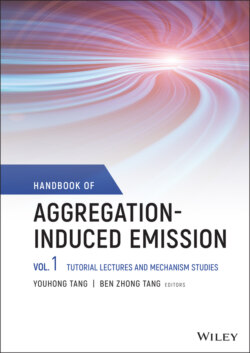Читать книгу Handbook of Aggregation-Induced Emission, Volume 1 - Группа авторов - Страница 45
2.5 Molecular Design Based on AIE Mechanism
ОглавлениеOn the basis of the above proposed AIE mechanism, we further rationally design a series of AIE probes for specific biological applications. Two representative amphiphilic AIEgens, TTVP [75] and TTPy [76], with similar structures were chosen as examples (Figure 2.3). As shown in Figure 2.3, the subtle difference in the chemical structures of them leads to dramatically different behavior in cell imaging. TTPy can penetrate the cell membrane and target mitochondria with excellent fluorescence imaging [76], while TTVP is able to specifically target and “light up” the lipid membrane [75]. Through a theoretical protocol combining large‐scale MD simulations and the hybrid QM/MM model, the mechanism behind their strikingly different fluorescence imaging behaviors was revealed [77]. The free‐energy profiles indicate that crossing the hydrophobic core of the lipid membrane, the free‐energy barrier for TTVP (30.44 kJ/mol) is much larger than that for TTPy (19.04 kJ/mol). The calculated permeability coefficient of TTPy (7.685 cm/s) is ca. 213 times larger than that of TTVP (3.612 × 10−2 cm/s), implying that TTPy could translocate through the lipid membrane and target mitochondria, while TTVP can target cell membrane.
As shown in Figure 2.10a, the QM/MM model of TTVP in the lipid membrane is set up to study its photophysical properties and to unravel the behind AIE mechanism. In both solution and lipid membrane, the quaternary 3‐(trimethylammonio)propyl group does not contribute to natural transition orbitals and thus no effect on the emission property (Figure 2.10b, c). Upon excitation from S0 to S1, the largest change of the dihedral angles is decreased from 24.8° to less than 4.7°, and the largest modification of the bond length is decreased from 0.07 to 0.02 Å (Figure 2.10d, e), indicating the stronger rigidity of TTVP in the lipid membrane. The calculated kr and kic in the THF solution are 3.3 × 108 and 2.4 × 1010 s−1, respectively; thus, ΦF is 1.3%, consistent with the nonemissive phenomenon of TTVP in dilute THF solution. While in lipid membrane, kr of TTVP is about 3.6 × 108 to 3.7×108 s−1, which is a little bit larger than that in solution, in addition, the λtotal of TTVP in the lipid membrane is much smaller than that in solution; thus, kic in the lipid membrane should also be small (Figure 2.10f). In addition, the emission of TTVP in the lipid membrane is blue‐shifted than in the THF solution (Figure 2.10g), consistent with the experimental result [75]. That is to say, the enhancement of kr and the decrease of kic turn the fluorescence on in the lipid membrane. Thus, the design strategy of AIEgen‐based fluorescent probes proposed that it is amphiphilic AIEgens, including AIE‐featured tail group and head group with different positive charges, to target the lipid membrane or mitochondria selectively. According to the design principle, four amphiphilic AIEgens were designed. Two of the designed AIEgens are composed of the AIE‐core and pyridine group, having TTPy‐analogue characteristics, while the other two AIEgens are structurally similar to TTVP, considering the inclusion of a functional group with two positive charges. The cell image experiments indicate that the newly designed TTPy‐analogues can translocate through the cell membrane and target mitochondria, while the TTVP analogues can selectively light up the cell membrane. The experimental results verified the theoretical prediction.
